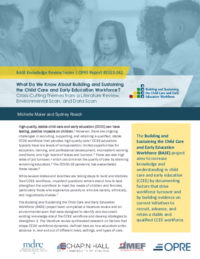What Do We Know About Building and Sustaining the Child Care and Early Education Workforce?
Cross-Cutting Themes from a Literature Review, Environmental Scan, and Data Scan

High-quality, stable child care and early education (CCEE) can have lasting, positive effects on children. However, there are ongoing challenges in recruiting, supporting, and retaining a CCEE workforce that provides high-quality care. CCEE educators typically have low levels of compensation; limited opportunities for education, training, and professional development; inconsistent working conditions; and high levels of stress and burnout. There are also high rates of job turnover, which can diminish the quality of care by straining remaining educators. The COVID-19 pandemic exacerbated these issues.
While several states are taking steps to build and stabilize their CCEE workforce, important questions remain about how to help the workforce meet the needs of children and families, particularly those who experience poverty or who are racially, ethnically, and linguistically diverse. The Building and Sustaining the Child Care and Early Education Workforce (BASE) project team conducted a literature review and an environmental scan. The literature review synthesized research on workforce dynamics—that is, how educators enter, advance in, and exit out of different roles, settings, and types of care. It predominantly focused on studies conducted between 2017 and 2021. The environmental scan identified and reviewed the strategies being used across the country to strengthen the CCEE workforce. The team also completed a data scan that assessed the strengths and weaknesses of several potential data sources that could be used to examine workforce dynamics and address key gaps in existing research.
This brief describes three of the cross-cutting themes from the literature review and the environmental scan: the field’s need for more and better data, the role of higher education in CCEE workforce dynamics, and the mismatch between the needs of a diverse CCEE workforce and existing strategies. It highlights where current strategies align with or diverge from the existing evidence base, identifies areas where additional research and data are needed, and provides recommendations for research and policy. Where relevant, the brief also points out complementary conclusions from the data scan.
Document Details
Maier and Roach (2024). What Do We Know About Building and Sustaining the Child Care and Early Education Workforce? Cross-Cutting Themes from a Literature Review, Environmental Scan, and Data Scan. OPRE Report 2023-242. Washington, DC: Office of Planning, Research, and Evaluation, Administration for Children and Families, U.S. Department of Health and Human Services. Available at: https://www.acf.hhs.gov/opre/project/building-and-sustaining-early-care…






